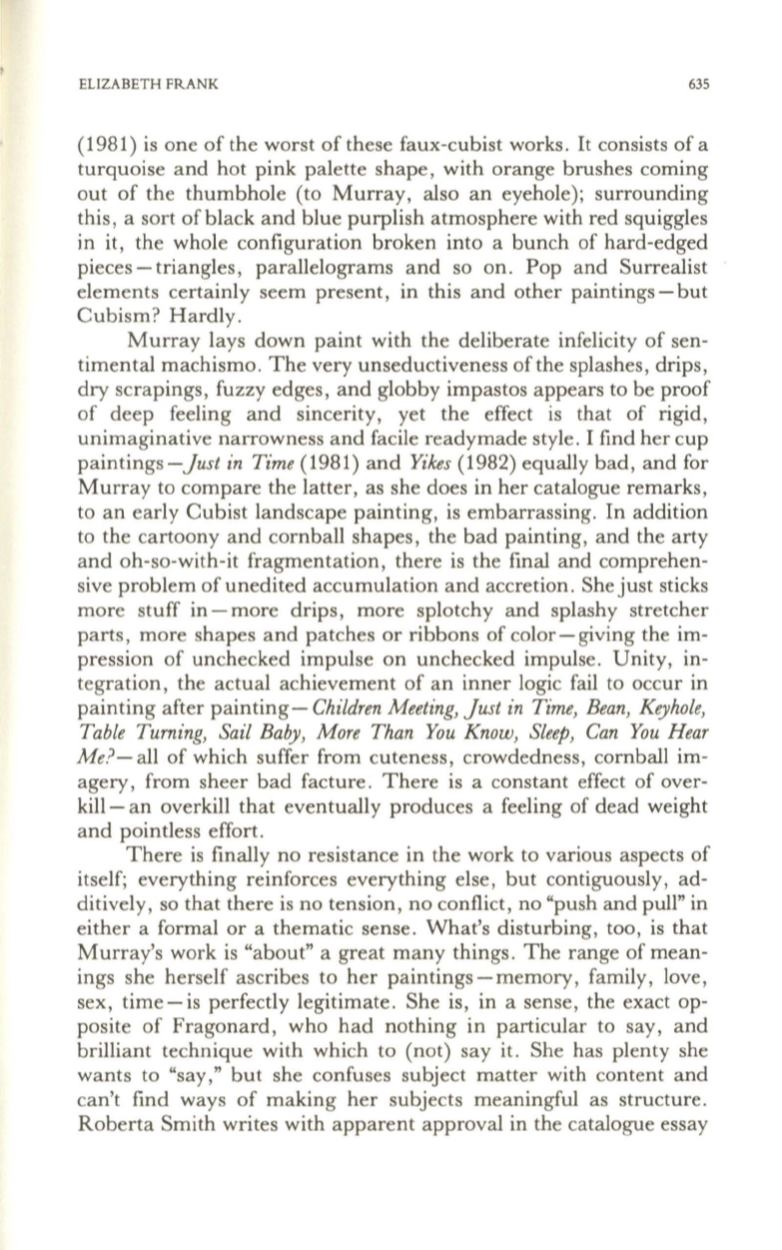
ELIZABETH FRANK
635
(1981) is one of the worst of these faux-cubist works. It consists of a
turquoise and hot pink palette shape, with orange brushes coming
out of the thumbhole (to Murray, also an eyehole); surrounding
this, a sort of black and blue purplish atmosphere with red squiggles
in it, the whole configuration broken into a bunch of hard-edged
pieces-triangles, parallelograms and so on. Pop and Surrealist
elements certainly seem present, in this and other paintings - but
Cubism? Hardly.
Murray lays down paint with the deliberate infelicity of sen–
timental machismo. The very unseductiveness of the splashes, drips,
dry scrapings, fuzzy edges, and globby impastos appears to be proof
of deep feeling and sincerity, yet the effect is that of rigid,
unimaginative narrowness and facile readymade style. I find her cup
paintings-Just
in Time
(1981) and
Yikes
(1982) equally bad, and for
Murray to compare the latter, as she does in her catalogue remarks,
to an early Cubist landscape painting, is embarrassing. In addition
to the cartoony and cornball shapes, the bad painting, and the arty
and oh-so-with-it fragmentation, there is the final and comprehen–
sive problem of unedited accumulation and accretion . She just sticks
more stuff in - more drips, more splotchy and splashy stretcher
parts, more shapes and patches or ribbons of color-giving the im–
pression of unchecked impulse on unchecked impulse . Unity, in–
tegration, the actual achievement of an inner logic fail to occur in
painting after painting-
Children Meeting, Just in Time, Bean, Keyhole,
Table Turning, Sail Baby, More Than You Know, Sleep, Can You Hear
Me?-
all of which suffer from cuteness, crowdedness, cornball im–
agery, from sheer bad facture . There is a constant effect of over–
kill- an overkill that eventually produces a feeling of dead weight
and pointless effort.
There is finally no resistance in the work to various aspects of
itself; everything reinforces everything else, but contiguously, ad–
ditively, so that there is no tension, no conflict, no "push and pull" in
either a formal or a thematic sense. What's disturbing, too, is that
Murray's work is "about" a great many things. The range of mean–
ings she herself ascribes to her paintings - memory, family, love,
sex, time - is perfectly legitimate. She is, in a sense, the exact op–
posite of Fragonard, who had nothing in particular to say, and
brilliant technique with which to (not) say it. She has plenty she
wants to "say," but she confuses subject matter with content and
can't find ways of making her subjects meaningful as structure.
Roberta Smith writes with apparent approval in the catalogue essay


